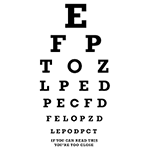The Value of Vision
by Toriann Maddux, OTS
Midwestern University Occupational Therapy Student
Did you know that vision accounts for as much as 80% of an individual’s learning process? If there’s a vision problem it will impede learning and development. Vision is not fully mature at birth but continues to develop through a learned process of looking, touching, and exploring the environment. There are 17 visual skills every individual needs in order to fully process the world around them.
Please visit this website to learn more about each of the 17 visual skills: http://www.covd.org/?page=Visual_Skills
Visual acuity is the most known visual skill but it is just one aspect of good vision. It doesn’t convey how much effort it takes an individual to see an image clearly. An individual can have 20/20 vision but still have a visual deficit. Signs and symptoms that may suggest a visual deficit include:
| · Headaches | · Burning, stinging, watery eyes |
| · Words run together when reading | · Reverses letter and words |
| · Difficulty copying from board | · Poor reading comprehension |
| · Bumps into things, knocks things over | · Double vision |
| · Trouble learning right and left | · Difficulty catching/hitting/throwing a ball |
| · Decrease coordination | · Delayed gross motor skills |
| · Inconsistent dominate handedness | · Difficulty in tasks crossing midline |
They may also demonstrate some behavioral characteristics such as:
| · Poor or short attentions span | · Avoids desk work and/or reading |
| · Demonstrates difficulty completing work | · Performs better when questions are given orally |
| · May appear lazy or uninterested | · Fidgety and/or restless |
| · Doesn’t pay attention to details | · Easily distracted |
If your child is experiencing these symptoms or behavioral characteristics, they may need vision therapy.
Vision therapy (VT) is provided by an optometrist (O.D., FCOVD) who specializes in developmental vision care and vision rehabilitation. Vision therapy aims to correct or improve visual skills and enable the ability to efficiently comprehend and use visual information. The activities and exercises help develop the appropriate pathways in the brain for each of the visual skills so they become automatic. Vision therapy can be done at any age and learning related vision problems are treatable. A vision therapy evaluation addresses 3 components:
- Comprehensive eye exam:
| · Visual acuity | · Eye focusing | · Depth perception |
| · Color vision | · Eye movement | · Eye muscle |
| · Peripheral vision | · Eye teaming | · Pupil response to light |
| · Keratometry | · Eye health | · Refraction |
- Visual efficiency exam:
| · Eye teaming | · Eye focusing | · Eye tracking |
- Visual information processing evaluation: this is the non-motor aspects of visual perception and cognition, and their integration with motor auditory, language and attention systems
| · Visual spatial orientation skills | · Visual analysis skills |
| · Visual-motor integration | · Auditory-visual integration |
“25% of students in grades K-6 have visual problems that are serious enough to impede learning”-American Public Health Association
Vision is a key element to an individual’s success and should be considered when learning and development are delayed. If you are interested in learning more about vision and vision therapy (VT), please check out the following links to learn more.
College of Optometrists in Vision Development (FCOVD)
- http://www.covd.org
- Doctor locator and VT info (click on Your Vision tab)
Parents Active for Vision Education
- http://pavevision.org/
- Non-profit organization promoting awareness of the relationship between vision and achievement
- VT info and IEP info
Optometrists Network
Vision Help
- http://visionhelp.com
- General vision info and SPD & vision problems
American Optometric Association
- www.aoa.org
- General vision info and resources
Seeing Smarter
- http://seeingsmarter.com
- VT info and vision & school







